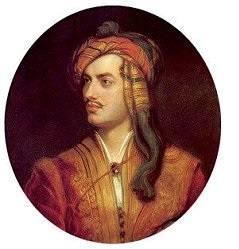 |
|
|
A Drop Of Ink
A Life of Lord Byron
"In my novel 'The House on Shaftesbury Hill', one of the characters, who is an illustrator of children's books, comes up with a character who she calls a 'pulchrasaurus', combining two Latin words, one of which means 'beauty' and the other 'beast'. Which of several characters in that book most epitomises the beautiful beast is hard to say; nor does it matter; the goal was to break free of the traditional falsehood of good versus evil, and to depict characters in whom a deeper truth about humanity is manifest: the fact that all of us are capable of both good and evil, and every shade of grey between those non-existent blacks and whites, and often simultaneously.
"It was many years after I had finished that, and several other books, that I realised how many of the historical figures that I was drawn to were pulchrasauri too, and that it had become a theme throughout my books: Wagner, King David, the Prophet Mohammed, to name just the three to whom I had dedicated a whole book, and not just a poem or an essay or a story.
"Lord Byron was cast from the same mould, a poetic genius who was also a monster, a man of endless and infinite contradictions, who lives on in the hall of fame of world literature, yet would have been imprisoned, possibly even hanged, had he returned to England to face up to his sins - not so much the debt or the adulteries, today not the homosexuality, but then, as now, the incest.
"When I sat down to write my biography of Byron, I wanted to find a way to get inside the man, to know what it was like to be him, and quickly realised that I could learn from books everything that led up to him sitting down to write, and everything that emerged from the act of writing, but not the process of writing itself. This is true of every writer of course, but with Byron I saw a way to possibly resolve the problem. That is why the book is written as he might have written it, mostly in ottava rima, briefly in terza rima, occasionally in heroic couplets. To catch the forms he used, but also the blend of romanticism with sarcasm, the epic satire that became his style."
David Prashker
|
 |
|
|
|
 |
|
